Designable Poly(methacrylic Acid)/Silver Cluster Ring Arrays as Reflectance Spectroscopy-Based Biosensors for Label-Free Plague Diagnosis
Abstract
1. Introduction
2. Experimental Section
2.1. Materials
2.2. Fabrication of the SPHR-Based Biosensor
2.3. Optical Properties of the SPHR-Based Biosensors
3. Results and Discussion
3.1. Surface Morphology Analyses at Each Stage for SPHR Fabrication
3.2. Measurement of Optical Property of the SPHR-Based Sensor
3.3. Preclinical Trials
4. Conclusions
Supplementary Materials
Author Contributions
Funding
Institutional Review Board Statement
Data Availability Statement
Acknowledgments
Conflicts of Interest
References
- Joseph, S.; Sarkar, S.; Joseph, J. Grating-Coupled Surface Plasmon-Polariton Sensing at a Flat Metal-Analyte Interface in a Hybrid-Configuration. ACS Appl. Mater. Interface 2020, 12, 46519–46529. [Google Scholar] [CrossRef] [PubMed]
- Brigo, L.; Gazzola, E.; Cittadini, M.; Zilio, P.; Zacco, G.; Romanato, F.; Martucci, A.; Guglielmi, M.; Brusatin, G. Short and long range surface plasmon polariton waveguides for xylene sensing. Nanotechnology 2013, 24, 155502. [Google Scholar] [CrossRef] [PubMed]
- Chubchev, E.D.; Nechepurenko, I.A.; Dorofeenko, A.V.; Vinogradov, A.P.; Lisyansky, A.A. Highly confined surface plasmon polaritons in the ultraviolet region. Opt. Express 2018, 26, 9050–9062. [Google Scholar] [CrossRef] [PubMed]
- Prakash, J.; Swart, H.C.; Zhang, G.; Sun, S. Emerging applications of atomic layer deposition for the rational design of novel nanostructures for surface-enhanced Raman scattering. J. Mater. Chem. C 2019, 7, 1447–1471. [Google Scholar] [CrossRef]
- Shin, Y.; Lee, S. Self-Organized Regular Arrays of Anodic TiO2 Nanotubes. Nano Lett. 2008, 8, 3171–3173. [Google Scholar] [CrossRef]
- Zeng, J.; Cheng, C.; Huang, B.; Huang, C.; Chen, J. Pillar arrays of tethered polyvinyltetrazole on silicon as a visualization platform for sensing of lead ions. Sens. Actuators B 2017, 243, 234–243. [Google Scholar] [CrossRef]
- Matschegewski, C.; Staehlke, S.; Loeffler, R.; Lange, R.; Chai, F.; Kern, D.P.; Beck, U.; Nebe, B.J. Cell architecture-cell function dependencies on titanium arrays with regular geometry. Biomaterials 2010, 31, 5729–5740. [Google Scholar] [CrossRef]
- Chen, J.-K.; Zhou, G.-Y.; Chang, C.-J.; Lee, A.-W.; Chang, F.-C. Label-free DNA detection using two-dimensional periodic relief array as a visualized platform for diagnosis of breast cancer recurrence after surgery. Biosens. Bioelectron. 2014, 54, 35–41. [Google Scholar] [CrossRef]
- Lalander, C.H.; Zheng, Y.; Dhuey, S.; Cabrini, S.; Bach, U. DNA-Directed Self-Assembly of Gold Nanoparticles onto Nanopatterned Surfaces: Controlled Placement of Individual Nanoparticles into Regular Arrays. ACS Nano 2010, 4, 6153–6161. [Google Scholar] [CrossRef]
- Chen, J.-K.; Chen, W.-T.; Cheng, C.-C.; Yu, C.-C.; Chu, J.P. Metallic glass nanotube arrays: Preparation and surface characterizations. Mater. Today 2017, 21, 178–185. [Google Scholar] [CrossRef]
- Van Nguyen, T.T.; Xie, X.; Xu, J.; Wu, Y.; Hong, M.; Liu, X. Plasmonic bimetallic nanodisk arrays for DNA conformation sensing. Nanoscale 2019, 11, 19291–19296. [Google Scholar] [CrossRef] [PubMed]
- Kim, S.; Bailey, S.; Liu, M.; Yan, R. Decoupling co-existing surface plasmon polariton (SPP) modes in a nanowire plasmonic waveguide for quantitative mode analysis. Nano Res. 2017, 10, 2395–2404. [Google Scholar] [CrossRef]
- Park, W.; Kodama, T.; Park, J.; Cho, J.; Sood, A.; Barako, M.T.; Asheghi, M.; Goodson, K.E. Thermal Conduction across Metal—Dielectric Sidewall Interfaces. ACS Appl. Mater. Interfaces 2017, 9, 30100–30106. [Google Scholar] [CrossRef] [PubMed]
- Xie, T.; Xu, D.; Shang, Y.; Li, Y.; Gu, Y.; Yang, G.; Qu, L. Highly sensitive SERS detection of IL-6 in serum by Au@Fe3O4 nanoring-based sandwich immunoassay. Sens. Actuator B 2023, 375, 132897. [Google Scholar] [CrossRef]
- Lin, F.; Hsu, H.; Chang, C.; Lu, C.; Chen, J. Isolation and label-free detection of circulating tumour cells by fluidic diffraction chips with a reflective laser beam system. Chem. Eng. J. 2022, 436, 135206. [Google Scholar] [CrossRef]
- Liu, X.; Liu, W.; Yang, B. Highly ordered 3D-silver nanoring arrays (3D-AgNRAs) for refractometric sensing. J. Mater. Chem. C 2019, 7, 7681–7691. [Google Scholar] [CrossRef]
- Singh, P.; Sharma, P.; Sharma, N.; Kaur, S. A perylene diimide-based nanoring architecture for exogenous and endogenous ATP detection: Biochemical assay for monitoring phosphorylation of glucose. J. Mater. Chem. B 2021, 10, 107–119. [Google Scholar] [CrossRef]
- Ngamaroonchote, A.; Liangruksa, M.; Hanlumyuang, Y.; Wijitwiengrat, T.; Laocharoensuk, R. A gold coated polystyrene ring microarray formed by two-step patterning: Construction of an advanced microelectrode for voltammetric sensing. Microchim. Acta 2019, 186, 349. [Google Scholar] [CrossRef]
- Jiang, N.; Hembree, G.G.; Spence, J.C.H.; Qiu, J.; de Abajo, F.J.G.; Silcox, J. Nanoring formation by direct-write inorganic electron-beam lithography. Appl. Phys. Lett. 2003, 83, 551–553. [Google Scholar] [CrossRef]
- Lewicka, Z.A.; Bahloul, A.; Yu, W.W.; Colvin, V.L. A facile fabrication process for polystyrene nanoring arrays. Nanoscale 2013, 5, 11071–11078. [Google Scholar] [CrossRef]
- Guo, K.; Teng, Y.; Guo, R.; Meng, Y.; Fan, D.; Hao, Q.; Zhang, Y.; Li, Y.; Xu, D. Engineering ultrathin PdAu nanoring via a facile process for electrocatalytic ethanol oxidation. J. Colloid Interface Sci. 2022, 628, 53–63. [Google Scholar] [CrossRef] [PubMed]
- Lee, S.H.; Choi, S.M.; Yoon, S.; Jeong, H.; Jung, G.Y.; Cho, B.K.; Kim, W.B. Transfer printing of metal nanoring and nanodot arrays for use in catalytic reactions. Chem. Commun. 2014, 50, 8472–8475. [Google Scholar] [CrossRef] [PubMed]
- Motloch, P.; Bols, P.S.; Anderson, H.L.; Hunter, C.A. Cooperative assembly of H-bonded rosettes inside a porphyrin nanoring. Chem. Sci. 2021, 12, 1427–1432. [Google Scholar] [CrossRef]
- Zeng, J.-R.; Cheng, C.-C.; Lee, A.-W.; Wei, P.-L.; Chen, J.-K. Visualization platform of one-dimensional arrays of tethered polyvinyltetrazole brushes on silicon surfaces for sensing of Cr (III). Microchim. Acta 2017, 184, 2723–2730. [Google Scholar] [CrossRef]
- Zhou, G.; Lee, A.; Chang, J.; Huang, C.; Chen, J. Fabrication of metamaterial absorber using polymer brush-gold nanoassemblies for visualizing the reversible pH-responsiveness. J. Mater. Chem. C 2014, 2, 8226–823421. [Google Scholar] [CrossRef]
- Park, S.; Wang, J.-Y.; Kim, B.; Russell, T.P. From Nanorings to Nanodots by Patterning with Block Copolymers. Nano Lett. 2008, 8, 1667–1672. [Google Scholar] [CrossRef]
- Zeng, J.-R.; Cheng, C.-C.; Chang, C.-J.; Huang, C.-H.; Chen, J.-K. Fabrication of two-dimensional photonic crystals of tethered polyvinyltetrazole on silicon surfaces for visualization in Cu2+ ion sensing. Dye. Pigment. 2017, 139, 300–309. [Google Scholar] [CrossRef]
- Chen, J.; Wang, J.; Cheng, C.; Chang, J. Reversibly Thermoswitchable Two-Dimensional Periodic Gratings Prepared from Tethered Poly(N-isopropylacrylamide) on Silicon Surfaces. ACS Appl. Mater. Interfaces 2013, 5, 2959–2966. [Google Scholar] [CrossRef]
- Chen, J.-K.; Pai, P.-C.; Chang, J.-Y.; Fan, S.-K. pH-Responsive One-Dimensional Periodic Relief Grating of Polymer Brush—Gold Nanoassemblies on Silicon Surface. ACS Appl. Mater. Interfaces 2012, 4, 1935–1947. [Google Scholar] [CrossRef]
- Cazares-Cortes, E.; Baker, B.C.; Nishimori, K.; Ouchi, M.; Tournilhac, F. Polymethacrylic Acid Shows Thermoresponsivity in an Organic Solvent. Macromolecules 2019, 52, 5995–6004. [Google Scholar] [CrossRef]
- Díez, I.; Kanyuk, M.I.; Demchenko, A.P.; Walther, A.; Jiang, H.; Ikkala, O.; Ras, R.H.A. Blue, green and red emissive silver nanoclusters formed in organic solvents. Nanoscale 2012, 4, 4434–4437. [Google Scholar] [CrossRef] [PubMed]
- Lee, A.; Cheng, C.; Chang, C.; Lu, C.; Chen, J. Optical assay of trypsin using a one-dimensional plasmonic array of gelatin-modified poly(methacrylic acid). Microchim. Acta 2020, 187, 280. [Google Scholar] [CrossRef] [PubMed]
- Chou, P.-C.; Chen, S.-H.; Chang, C.-J.; Lu, C.-H.; Chen, J.-K. Detection of heavy metal ion using photonic crystals of polymer brushes with reflective laser beam system. Appl. Surf. Sci. 2022, 585, 152718. [Google Scholar] [CrossRef]
- Chen, J.-K.; Wang, J.-H.; Cheng, C.-C.; Chang, J.-Y.; Chang, F.-C. Polarity-indicative two-dimensional periodic relief arrays of tethered poly (methyl methacrylate) on silicon surfaces for visualization in volatile organic compound sensing. Appl. Phys. Lett. 2013, 102, 151906. [Google Scholar] [CrossRef]
- Lin, F.-P.; Hsu, H.-L.; Tsui, P.-Y.; Liang, C.-C.; Lu, C.-H.; Chen, J.-K. One-dimensional diffraction sensors with high sensitivity for on-site rapid label-free plague diagnosis with a reflective laser detection system. Sens. Actuators B Chem. 2022, 353, 131080. [Google Scholar] [CrossRef]
- Guo, J.-W.; Huang, B.-R.; Lai, J.-Y.; Lu, C.-H.; Chen, J.-K. Reversibly photoswitchable gratings prepared from azobenzene-modified tethered poly(methacrylic acid) brush as colored actuator. Sens. Actuators B Chem. 2019, 304, 127275. [Google Scholar] [CrossRef]
- Chen, W.-T.; Li, S.-S.; Chu, J.P.; Feng, K.C.; Chen, J.-K. Fabrication of ordered metallic glass nanotube arrays for label-free biosensing with diffractive reflectance. Biosens. Bioelectron. 2018, 102, 129–135. [Google Scholar] [CrossRef]
- Chen, J.-K.; Qui, J.-Q. Patterned 3D assembly of Au nanoparticle on silicon substrate by colloid lithography. J. Nanopart. Res. 2012, 14, 942. [Google Scholar] [CrossRef]
- Sheeney-Haj-Ichia, L.; Sharabi, G.; Willner, I. Control of the Electronic Properties of Thermosensitive Poly(N-isopropylacrylamide) and Au-Nanoparticle/Poly(N-isopropylacrylamide) Composite Hydrogels upon Phase Transition. Adv. Funct. Mater. 2002, 12, 27–32. [Google Scholar] [CrossRef]
- Aqil, A.; Qiu, H.; Greisch, J.-F.; Jérôme, R.; De Pauw, E.; Jérôme, C. Coating of gold nanoparticles by thermosensitive poly(N-isopropylacrylamide) end-capped by biotin. Polymer 2008, 49, 1145–1153. [Google Scholar] [CrossRef]
- Lin, F.-P.; Hsu, H.-L.; Chang, C.-J.; Lee, S.-C.; Chen, J.-K. Surface lattice resonance of line array of poly (glycidyl methacrylate) with CdS quantum dots for label-free biosensing. Colloids Surf. B Biointerfaces 2019, 179, 199–207. [Google Scholar] [CrossRef] [PubMed]
- Sha, J.; Endsley, J.J.; Kirtley, M.L.; Foltz, S.M.; Huante, M.B.; Erova, T.E.; Kozlova, E.V.; Popov, V.L.; Yeager, L.A.; Zudina, I.V.; et al. Characterization of an F1 Deletion Mutant of Yersinia pestis CO92, Pathogenic Role of F1 Antigen in Bubonic and Pneumonic Plague, and Evaluation of Sensitivity and Specificity of F1 Antigen Capture-Based Dipsticks. J. Clin. Microbiol. 2011, 49, 1708–1715. [Google Scholar] [CrossRef]
- Liao, B.-Y.; Chang, C.-J.; Wang, C.-F.; Lu, C.-H.; Chen, J.-K. Controlled antibody orientation on Fe3O4 nanoparticles and CdTe quantum dots enhanced sensitivity of a sandwich-structured electrogenerated chemiluminescence immunosensor for the determination of human serum albumin. Sens. Actuators B Chem. 2021, 336, 129710. [Google Scholar] [CrossRef]
- Chen, J.-K.; Chen, T.-Y. Fabrication of high-aspect-ratio poly(2-hydroxyethyl methacrylate) brushes patterned on silica surfaces by very-large-scale integration process. J. Colloid Interface Sci. 2011, 355, 359–367. [Google Scholar] [CrossRef] [PubMed]
- Horváth, B.; Kawakita, J.; Chikyow, T. Adhesion of silver/polypyrrole nanocomposite coating to afluoropolymer substrate. Appl. Surf. Sci. 2016, 384, 1492–1496. [Google Scholar] [CrossRef]
- Chen, J.-K.; Zhou, G.-Y.; Chang, C.-J. Real-time multicolor antigen detection with chemoresponsive diffraction gratings of silicon oxide nanopillar arrays. Sens. Actuators B Chem. 2013, 186, 802–810. [Google Scholar] [CrossRef]
- Limonov, M.F.; Rybin, M.V.; Poddubny, A.N.; Kivshar, S.Y. Fano resonances in photonics. Nat. Photon. 2017, 11, 543–554. [Google Scholar] [CrossRef]
- Hao, F.; Sonnefraud, Y.; Dorpe, P.V.; Maier, S.A.; Halas, N.J.; Nordlander, P. Symmetry Breaking in Plasmonic Nanocavities: Subradiant LSPR Sensing and a Tunable Fano Resonance. Nano Lett. 2008, 8, 3983–3988. [Google Scholar] [CrossRef]
- Fedotov, V.A.; Rose, M.; Prosvirnin, S.L.; Papasimakis, N.; Zheludev, N.I. Sharp Trapped-Mode Resonances in Planar Metamaterials with a Broken Structural Symmetry. Phys. Rev. Lett. 2007, 99, 147401. [Google Scholar] [CrossRef]
- Aizpurua, J.; Hanarp, P.; Sutherland, D.S.; Ka¨ll, M.; Bryant, G.W.; Gracı’a de Abajio, F.J. Optical Properties of Gold Nanorings. Phys. Rev. Lett. 2003, 90, 057401. [Google Scholar] [CrossRef]
- Zhang, N.; Su, X.; Free, P.; Zhou, X.; Neoh, K.G.; Teng, J.; Knoll, W. Plasmonic metal nanostructure array by glancing angle deposition for biosensing application. Sens. Actuator. B 2013, 183, 310–318. [Google Scholar] [CrossRef]
- Mwanza, D.; Mfamela, N.; Adeniyi, O.; Nyokong, T.; Mashazi, P. Ultrasensitive detection of prostate-specific antigen using glucose-encapsulated nanoliposomes anti-PSA polyclonal antibody as detection nanobioprobes. Talanta 2022, 245, 123483. [Google Scholar] [CrossRef] [PubMed]
- Tian, B.; Wetterskog, E.; Qiu, Z.; de la Torre, T.Z.G.; Donolato, M.; Hansen, M.F.; Svedlindh, P.; Strömberg, M. Shape anisotropy enhanced optomagnetic measurement for prostate-specific antigen detection via magnetic chain formation. Biosens. Bioelectron. 2017, 98, 285–291. [Google Scholar] [CrossRef]
- Aydın, E.B.; Aydın, M.; Sezgintürk, M.K. Construction of succinimide group substituted polythiophene polymer functionalized sensing platform for ultrasensitive detection of KLK 4 cancer biomarker. Sens. Actuators B Chem. 2020, 325, 128788. [Google Scholar] [CrossRef]
- Guo, X.; Wang, M.; Ma, L.; Cui, Z.; Liu, Z.; Yang, H.; Liu, Y. Carboxyl porphyrin as signal molecule for sensitive fluorescent detection of aflatoxin B1 via ARGET-ATRP. Spectrochim. Acta Part A Mol. Biomol. Spectrosc. 2022, 280, 121535. [Google Scholar] [CrossRef] [PubMed]

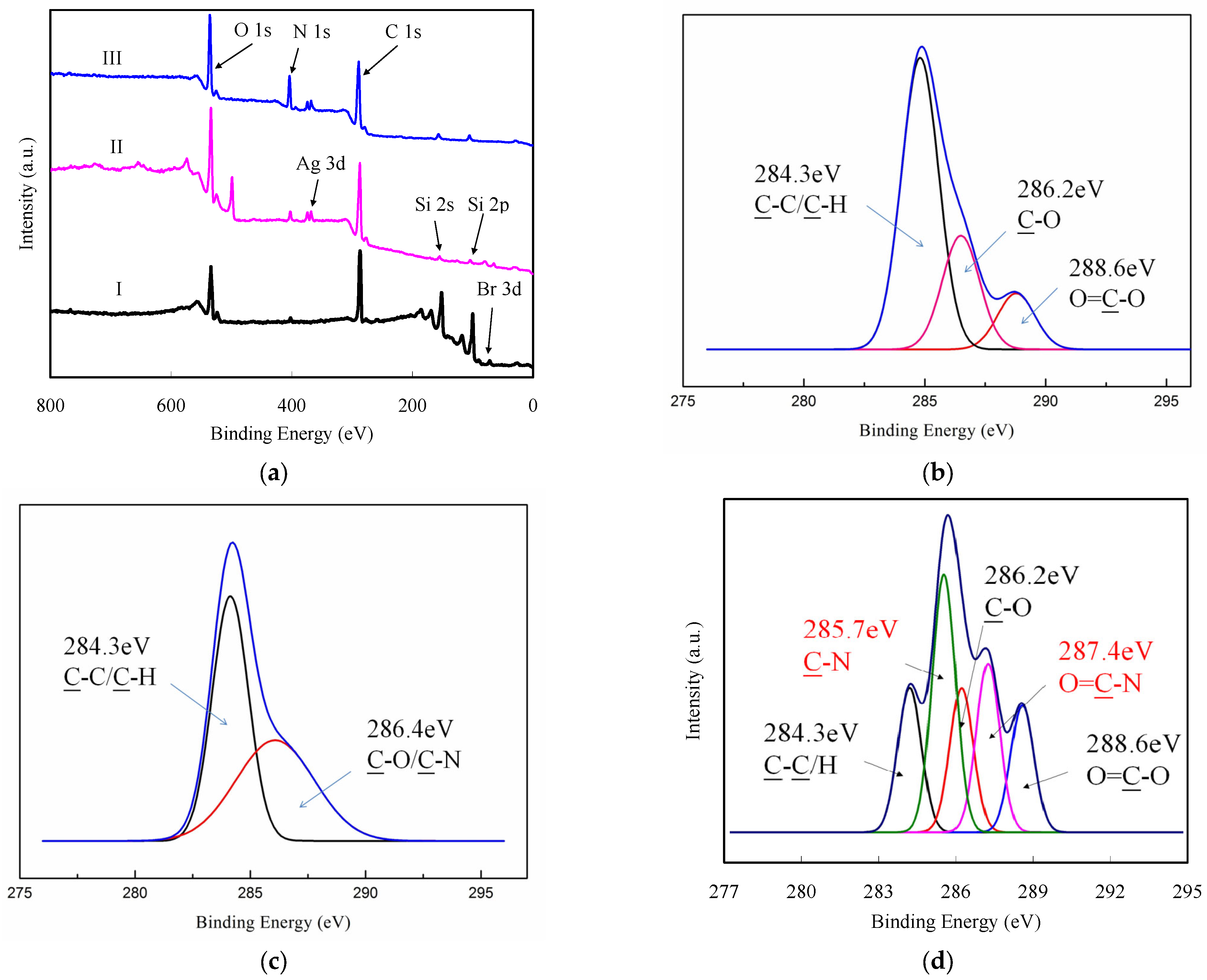
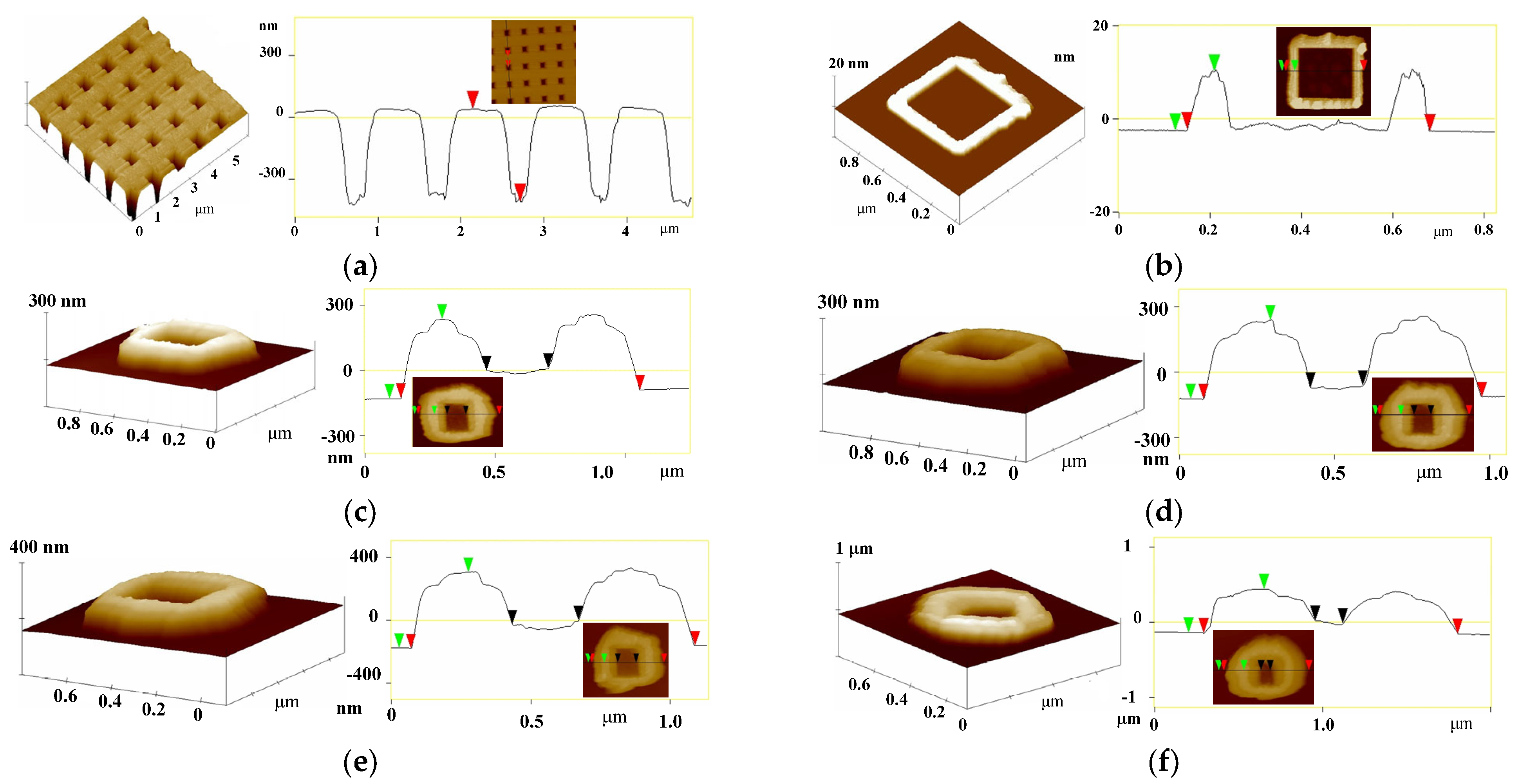

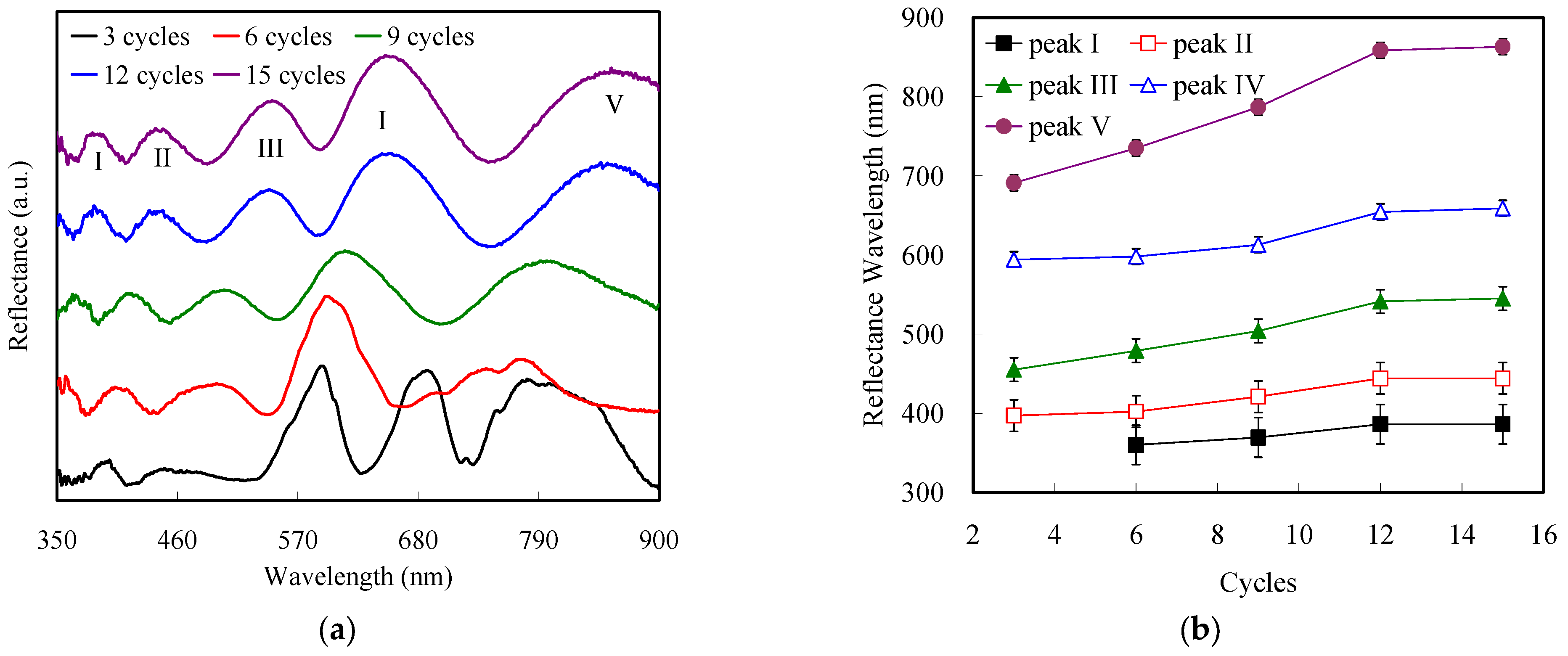
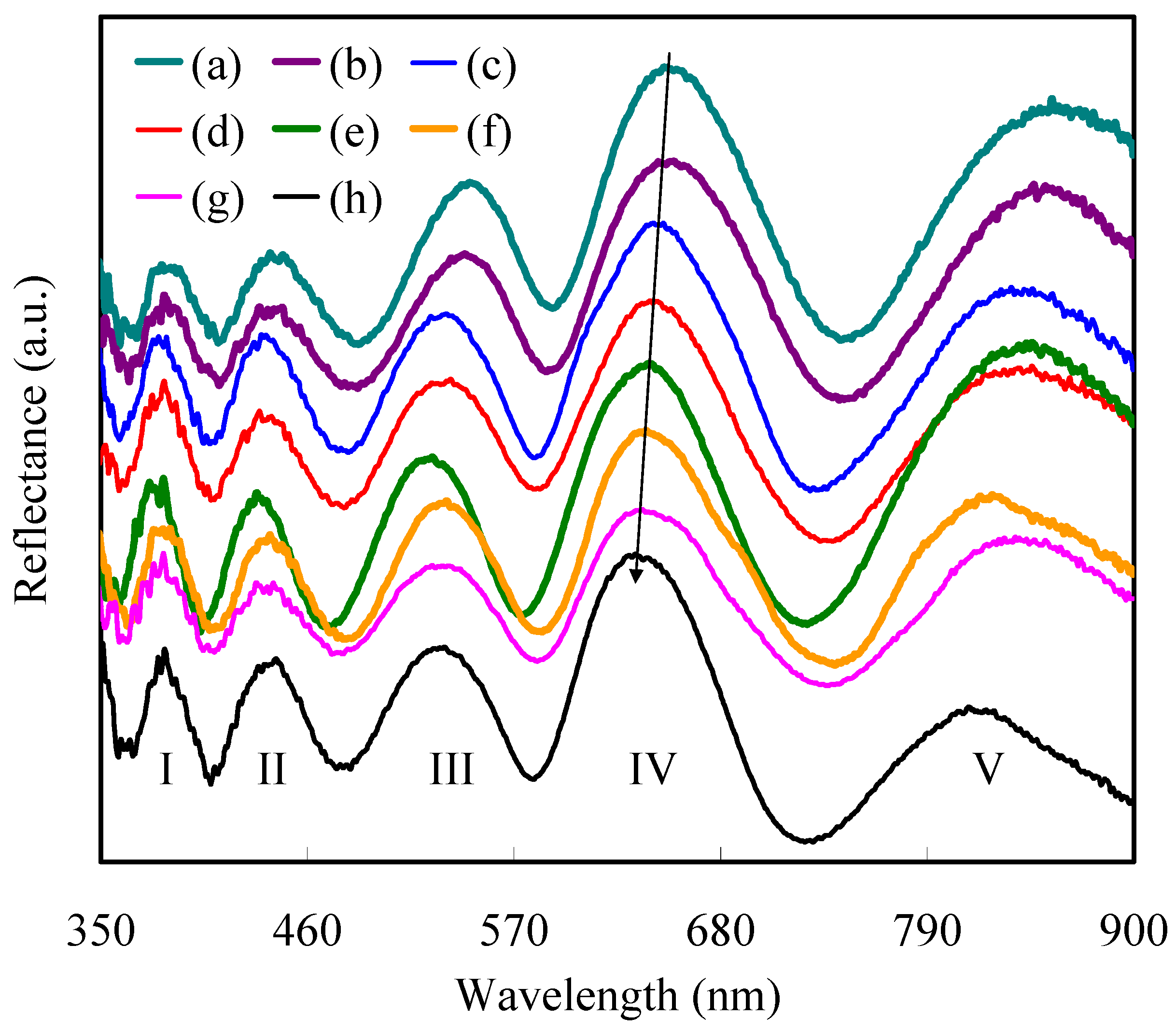
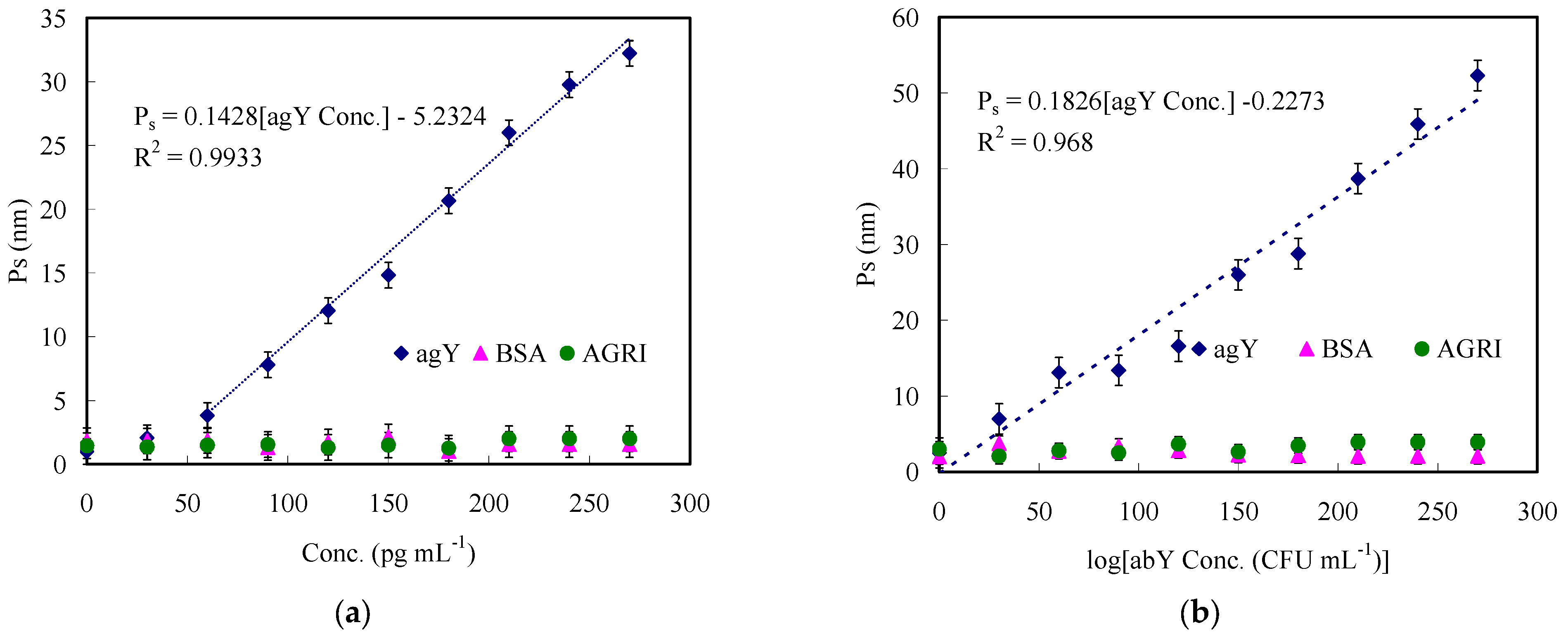
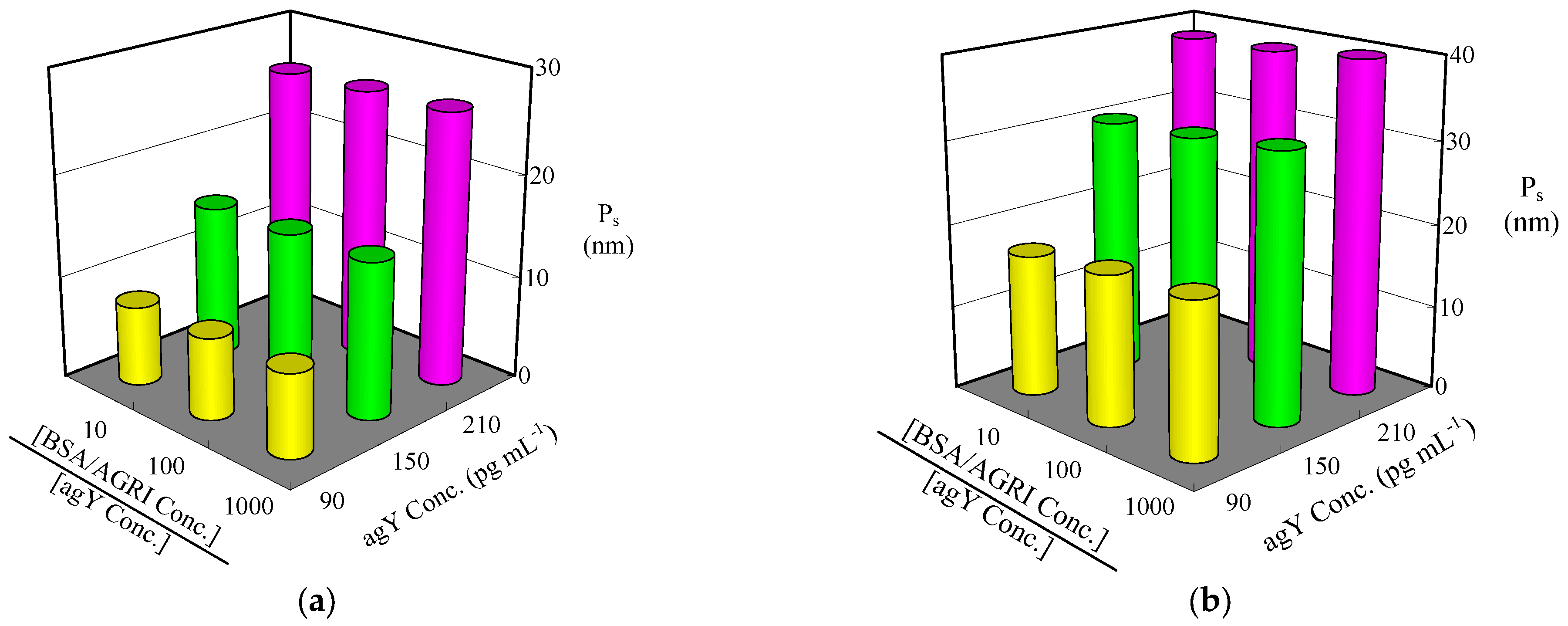
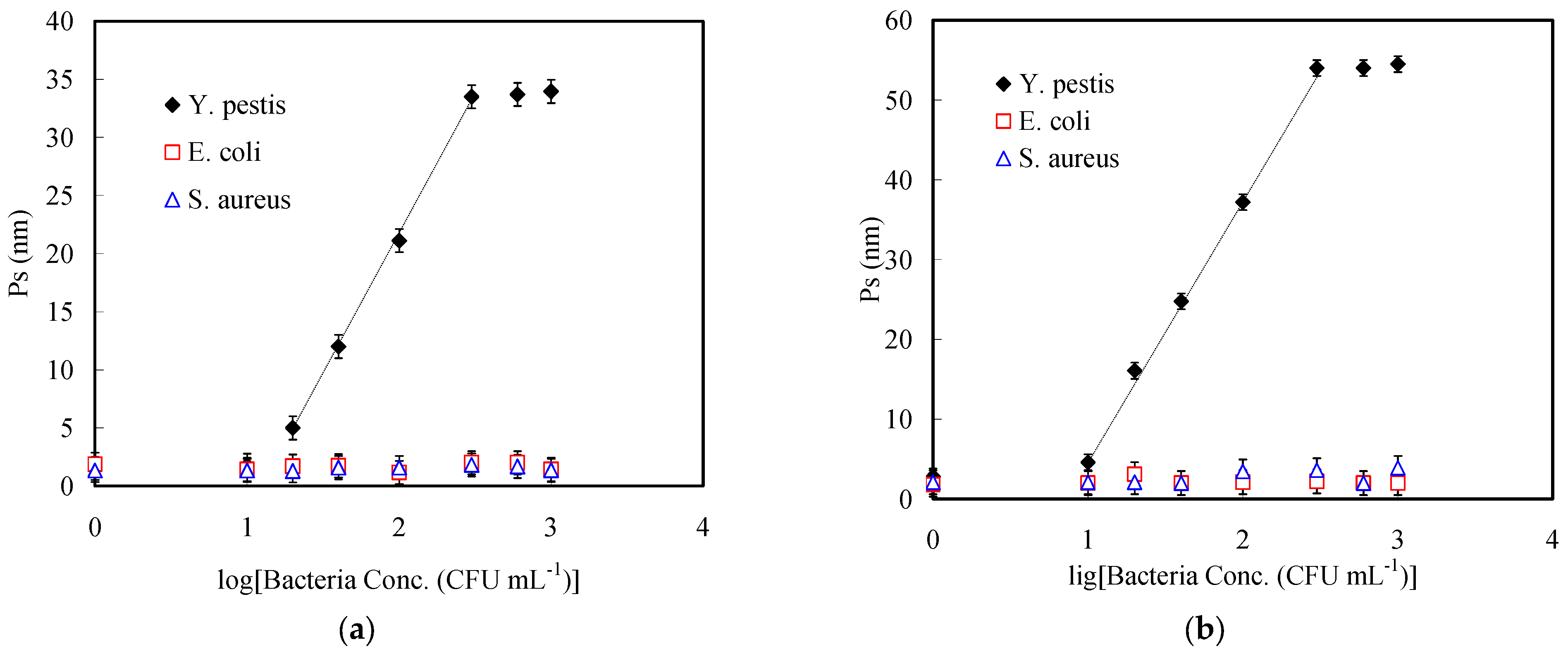
| Sample | Content (at%) | Chemical Composition | |||||||
|---|---|---|---|---|---|---|---|---|---|
| Si | C | O | N | Ag | [C]/[Si] | [O]/[Si] | [N]/[Si] | [Ag]/[Si] | |
| PMAA | 18.55 | 54.91 | 26.51 | 0.02 | 0.01 | 2.96 | 1.43 | 0.00 | 0.00 |
| AgCs-PMAA | 3.45 | 52.31 | 24.35 | 5.08 | 14.81 | 15.16 | 7.06 | 1.47 | 4.29 |
| abY-grafted AgCs-PMAA | 2.03 | 53.11 | 25.33 | 6.55 | 12.98 | 26.16 | 12.48 | 3.23 | 6.39 |
| Sample No. | ELISA (pg mL−1) | SPHR Sensor (pg mL−1) | RSD (%) |
|---|---|---|---|
| 1 a | 126.18 ± 1.14 | 133.49 ± 1.49 | 5.79 |
| 2 b | 253.26 ± 2.31 | 266.92 ± 2.53 | 5.39 |
| 3 c | 378.39 ± 3.94 | 398.51 ± 3.58 | 5.32 |
| Initial Concentration | Post-Spike Measurements | Recovery d | Bias e | RSD | |||
|---|---|---|---|---|---|---|---|
| Y. pestis (CFU mL−1) | agY (pg mL−1) | Spiked (pg mL−1) | Measured (pg mL−1) | (%) | (%) | (%, n = 3) | |
| 1 a | 50 | 62.11 ± 5.14% | 17.64 | 81.74 | 102.49 | 2.49 | 4.19 |
| 35.27 | 95.62 | 98.19 | −1.81 | 3.98 | |||
| 69.89 | 136.12 | 103.12 | 3.12 | 4.74 | |||
| 2 b | 25 | 31.79 ± 5.34% | 17.64 | 48.16 | 97.43 | −2.57 | 5.31 |
| 35.27 | 66.09 | 98.55 | −1.45 | 5.22 | |||
| 69.89 | 105.48 | 103.74 | 3.74 | 4.92 | |||
| 3 c | 12.5 | 22.43 ± 6.48% | 17.64 | 42.07 | 104.98 | 4.98 | 6.34 |
| 35.27 | 55.51 | 96.21 | −3.79 | 6.05 | |||
| 69.89 | 89.65 | 97.11 | −2.89 | 5.95 | |||
| Materials | Sensor Species | Linear Range | LOD | Ref. |
|---|---|---|---|---|
| Glucose-encapsulated nanoliposomes | Sandwich immunoassay | 4–10 ng mL−1 | 64 fg mL−1 | [52] |
| Magnetic nanoparticle | Optomagnetic sensor | 0.1–104 ng mL−1 | 0.82 ng mL−1 | [53] |
| Metallic glass nanotube | Diffractive reflectance sensor | 25–125 nM | 25 nM | [37] |
| Succinimide group substituted polythiophene polymer | Electrochemical sensor | 0.04–30 pg m−1 | 12.2 fg mL−1 | [54] |
| Carboxy magnetic beads | Fluorescent sensor | 0.1–100 ng mL−1 | 8.38 fg mL−1 | [55] |
| SPHR array | Reflectance sensor | 30–150 pg mL−1 | 12.3 pg mL−1 | Present work |
Disclaimer/Publisher’s Note: The statements, opinions and data contained in all publications are solely those of the individual author(s) and contributor(s) and not of MDPI and/or the editor(s). MDPI and/or the editor(s) disclaim responsibility for any injury to people or property resulting from any ideas, methods, instructions or products referred to in the content. |
© 2023 by the authors. Licensee MDPI, Basel, Switzerland. This article is an open access article distributed under the terms and conditions of the Creative Commons Attribution (CC BY) license (https://creativecommons.org/licenses/by/4.0/).
Share and Cite
Chen, C.-W.; Chen, S.-H.; Huang, C.-F.; Chen, J.-K. Designable Poly(methacrylic Acid)/Silver Cluster Ring Arrays as Reflectance Spectroscopy-Based Biosensors for Label-Free Plague Diagnosis. Polymers 2023, 15, 1919. https://doi.org/10.3390/polym15081919
Chen C-W, Chen S-H, Huang C-F, Chen J-K. Designable Poly(methacrylic Acid)/Silver Cluster Ring Arrays as Reflectance Spectroscopy-Based Biosensors for Label-Free Plague Diagnosis. Polymers. 2023; 15(8):1919. https://doi.org/10.3390/polym15081919
Chicago/Turabian StyleChen, Chih-Wei, Shih-Hsun Chen, Chih-Feng Huang, and Jem-Kun Chen. 2023. "Designable Poly(methacrylic Acid)/Silver Cluster Ring Arrays as Reflectance Spectroscopy-Based Biosensors for Label-Free Plague Diagnosis" Polymers 15, no. 8: 1919. https://doi.org/10.3390/polym15081919
APA StyleChen, C.-W., Chen, S.-H., Huang, C.-F., & Chen, J.-K. (2023). Designable Poly(methacrylic Acid)/Silver Cluster Ring Arrays as Reflectance Spectroscopy-Based Biosensors for Label-Free Plague Diagnosis. Polymers, 15(8), 1919. https://doi.org/10.3390/polym15081919








